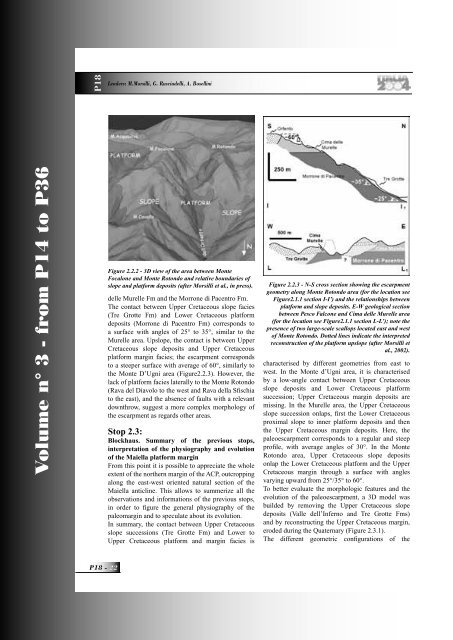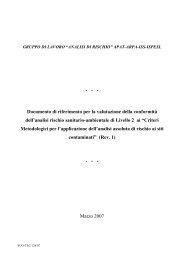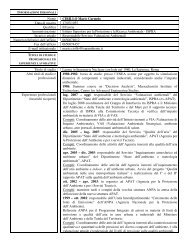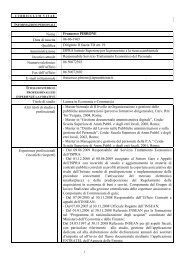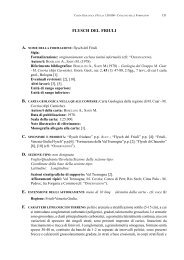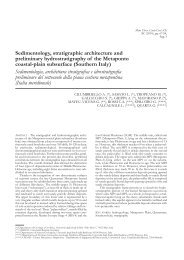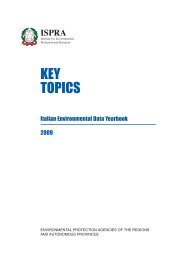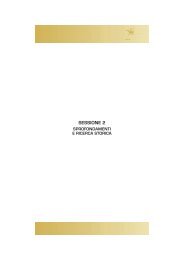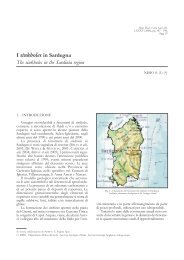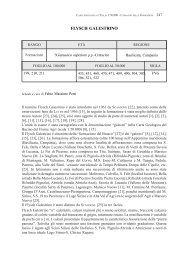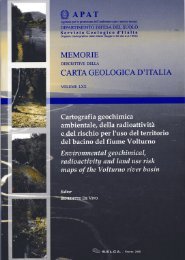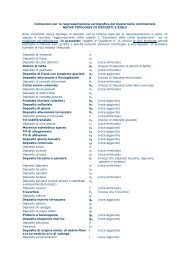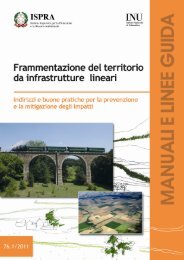Guidebook - Ispra
Guidebook - Ispra
Guidebook - Ispra
You also want an ePaper? Increase the reach of your titles
YUMPU automatically turns print PDFs into web optimized ePapers that Google loves.
Volume n° 3 - from P14 to P36<br />
P18<br />
P18 -<br />
Leaders: M.Morsilli, G. Rusciadelli, A. Bosellini<br />
Figure 2.2.2 - 3D view of the area between Monte<br />
Focalone and Monte Rotondo and relative boundaries of<br />
slope and platform deposits (after Morsilli et al., in press).<br />
delle Murelle Fm and the Morrone di Pacentro Fm.<br />
The contact between Upper Cretaceous slope facies<br />
(Tre Grotte Fm) and Lower Cretaceous platform<br />
deposits (Morrone di Pacentro Fm) corresponds to<br />
a surface with angles of 25° to 35°, similar to the<br />
Murelle area. Upslope, the contact is between Upper<br />
Cretaceous slope deposits and Upper Cretaceous<br />
platform margin facies; the escarpment corresponds<br />
to a steeper surface with average of 60°, similarly to<br />
the Monte D’Ugni area (Figure2.2.3). However, the<br />
lack of platform facies laterally to the Monte Rotondo<br />
(Rava del Diavolo to the west and Rava della Sfi schia<br />
to the east), and the absence of faults with a relevant<br />
downthrow, suggest a more complex morphology of<br />
the escarpment as regards other areas.<br />
Stop 2.3:<br />
Blockhaus. Summary of the previous stops,<br />
interpretation of the physiography and evolution<br />
of the Maiella platform margin<br />
From this point it is possible to appreciate the whole<br />
extent of the northern margin of the ACP, outcropping<br />
along the east-west oriented natural section of the<br />
Maiella anticline. This allows to summerize all the<br />
observations and informations of the previous stops,<br />
in order to fi gure the general physiography of the<br />
paleomargin and to speculate about its evolution.<br />
In summary, the contact between Upper Cretaceous<br />
slope successions (Tre Grotte Fm) and Lower to<br />
Upper Cretaceous platform and margin facies is<br />
Figure 2.2.3 - N-S cross section showing the escarpment<br />
geometry along Monte Rotondo area (for the location see<br />
Figure2.1.1 section I-I’) and the relationships between<br />
platform and slope deposits. E-W geological section<br />
between Pesco Falcone and Cima delle Murelle area<br />
(for the location see Figure2.1.1 section L-L’); note the<br />
presence of two large-scale scallops located east and west<br />
of Monte Rotondo. Dotted lines indicate the interpreted<br />
reconstruction of the platform upslope (after Morsilli et<br />
al., 2002).<br />
characterised by different geometries from east to<br />
west. In the Monte d’Ugni area, it is characterised<br />
by a low-angle contact between Upper Cretaceous<br />
slope deposits and Lower Cretaceous platform<br />
succession; Upper Cretaceous margin deposits are<br />
missing. In the Murelle area, the Upper Cretaceous<br />
slope succession onlaps, fi rst the Lower Cretaceous<br />
proximal slope to inner platform deposits and then<br />
the Upper Cretaceous margin deposits. Here, the<br />
paleoescarpment corresponds to a regular and steep<br />
profi le, with average angles of 30°. In the Monte<br />
Rotondo area, Upper Cretaceous slope deposits<br />
onlap the Lower Cretaceous platform and the Upper<br />
Cretaceous margin through a surface with angles<br />
varying upward from 25°/35° to 60°.<br />
To better evaluate the morphologic features and the<br />
evolution of the paleoescarpment, a 3D model was<br />
builded by removing the Upper Cretaceous slope<br />
deposits (Valle dell’Inferno and Tre Grotte Fms)<br />
and by reconstructing the Upper Cretaceous margin,<br />
eroded during the Quaternary (Figure 2.3.1).<br />
The different geometric confi gurations of the


